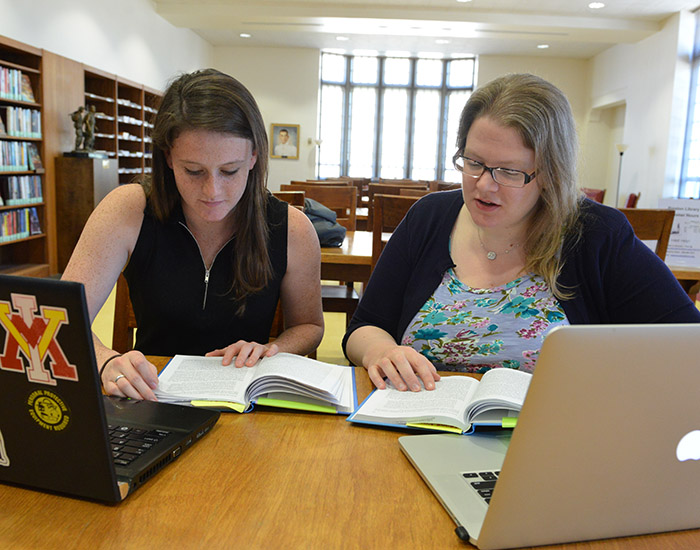‘A Big Conversation’
 |
| Sarah Lemon ’17 and Maj. Julie Brown compare versions of Dickinson’s poetry in the Preston Library reading room. – VMI Photo by Kelly Nye. |
LEXINGTON, Va., June 20, 2016 – A summer undergraduate research project focused on the work of the 19th-century poet Emily Dickinson has taught Sarah Lemon ’17 that analyzing a text is like digging a hole in the ground – there are layers and layers to sift through, with no bottom in sight.
Just as the digger will never hit bottom, the scholar will also never run out of possible interpretations, particularly when there are multiple versions of the text available, all prepared for publication by different editors.
Lemon, who has been writing poetry herself since childhood, has long admired the work of Dickinson, a reclusive New England poet known for her abbreviated lines, generous use of dashes, and seemingly random capitalization of words.
When Lemon realized that she’d like to participate in VMI’s Summer Undergraduate Research Institute program, she immediately sought out as her faculty adviser Maj. Julie Brown, assistant professor of English, rhetoric, and humanistic studies, as Brown is an expert on American poetry and is currently writing an article on Dickinson.
Much of Lemon’s work this summer has focused on comparing different versions of a single, untitled Dickinson poem with the first line, “Truth is as Old as God.” This eight-line verse, most likely written about 1864 but not published until 1894, has no single, authoritative version, as two versions exist in Dickinson’s handwriting.
To further confound matters, neither of the handwritten versions includes any stanza break, although one was added by a later editor and thus many published versions of the poem include a break between the fourth and fifth lines.
“There’s a lot of ambiguity about how much of [Dickinson’s] work is her own and how much was changed,” noted Lemon, who is planning to earn a master of fine arts degree after she graduates from VMI.
The importance of editors, and editorial discretion, cannot be overstated, Brown believes.
“There’s been different schools of thought about editing,” said Brown. “They definitely inform the text we end up working with as literary scholars, so we ought to pay attention to editing, particularly as it pertains to manuscript culture.”
In Dickinson’s case, that manuscript culture has produced multiple versions of the nearly 1,800 poems Dickinson wrote in her relatively short lifetime of 55 years.
“Some of [the editors] try to standardize the poem and some of them try to retain all of the original idiosyncrasies of the manuscript,” Brown noted. “There are different sets of values at stake in the ways they approach editing a manuscript.”
To evaluate the various approaches taken by editors, Lemon has borrowed the concept of “unediting,” or treating all versions of a text as having equal weight. Brown explained that the term “unediting” was coined by Renaissance scholar Leah Marcus in her 1996 volume, Unediting the Renaissance.
“There’s an attraction to this process of unediting,” Lemon commented, “and getting down to what the poet originally meant, but you’re posed with the question: Does that mean the very first copy? The most recent copy? … By changing absolutely anything at all, like even the handwriting, are you taking away the authenticity of the poem?”
In her efforts to get at Dickenson’s authentic voice, Lemon has been aided by digital archives of the poet’s work available online at edickinson.org, a collaborative effort of many libraries, colleges, and universities, among them Amherst College and Harvard University, where the majority of Dickinson’s papers are held.
Brown noted that a project such as this would have much more difficult in the pre-Internet era; the digital collections include features such as being able to compare different versions of a poem side by side.
It’s just those variations that provide scholars with material to study – and Lemon has found herself taking a seat at the table, metaphorically if not literally, with those established scholars who may have spent decades studying Dickinson’s work.
“It’s really cool to read different editors’ opinions and critiques and form my own voice,” she said. “Even if it’s just inside my own head, I’m placing myself in this conversation among all these scholars. … It’s a big conversation that I’m entering into, but I’m enjoying it.”
–Mary Price
-VMI-
.svg)
.png)